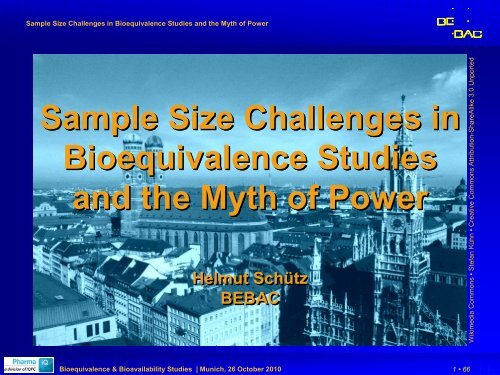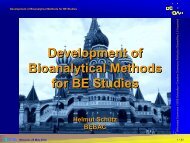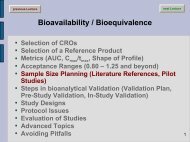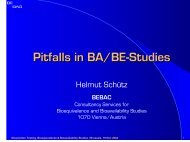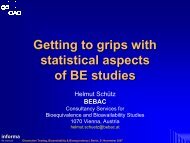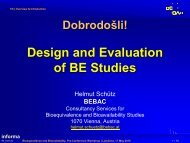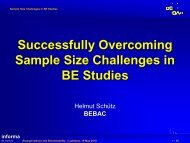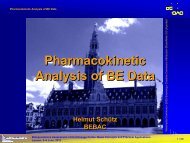Sample Size Challenges in BE Studies and the Myth of Power
Sample Size Challenges in BE Studies and the Myth of Power
Sample Size Challenges in BE Studies and the Myth of Power
You also want an ePaper? Increase the reach of your titles
YUMPU automatically turns print PDFs into web optimized ePapers that Google loves.
<strong>Sample</strong> <strong>Size</strong> <strong>Challenges</strong> <strong>in</strong> Bioequivalence <strong>Studies</strong> <strong>and</strong> <strong>the</strong> <strong>Myth</strong> <strong>of</strong> <strong>Power</strong><br />
<strong>Sample</strong> <strong>Size</strong> <strong>Challenges</strong> <strong>in</strong><br />
Bioequivalence <strong>Studies</strong><br />
<strong>and</strong> <strong>the</strong> <strong>Myth</strong> <strong>of</strong> <strong>Power</strong><br />
Helmut Schütz<br />
<strong>BE</strong>BAC<br />
Wikimedia Commons • Stefan Kühn • Creative Commons Attribution-ShareAlike<br />
3.0 Unported<br />
Bioequivalence & Bioavailability <strong>Studies</strong> | Munich, 26 October 2010<br />
1 • 66
<strong>Sample</strong> <strong>Size</strong> <strong>Challenges</strong> <strong>in</strong> Bioequivalence <strong>Studies</strong> <strong>and</strong> <strong>the</strong> <strong>Myth</strong> <strong>of</strong> <strong>Power</strong><br />
<strong>Sample</strong> <strong>Size</strong> (Limits)<br />
M<strong>in</strong>imum<br />
12: WHO, EU, CAN, NZ, AUS, AR, MZ, ASEAN States,<br />
RSA<br />
12: USA ‘A pilot study that documents <strong>BE</strong> can be<br />
appropriate, provided its design <strong>and</strong> execution are<br />
suitable <strong>and</strong> a sufficient number <strong>of</strong> subjects (e.g.,<br />
12) have completed <strong>the</strong> study.’<br />
20: RSA (MR formulations)<br />
24: Saudia Arabia (12 to 24 if statistically justifiable)<br />
24: Brazil<br />
Sufficient number: JPN<br />
Bioequivalence & Bioavailability <strong>Studies</strong> | Munich, 26 October 2010<br />
2 • 66
<strong>Sample</strong> <strong>Size</strong> <strong>Challenges</strong> <strong>in</strong> Bioequivalence <strong>Studies</strong> <strong>and</strong> <strong>the</strong> <strong>Myth</strong> <strong>of</strong> <strong>Power</strong><br />
<strong>Sample</strong> <strong>Size</strong> (Limits)<br />
Maximum<br />
NZ: ‘If <strong>the</strong> calculated number <strong>of</strong> subjects appears to be<br />
higher than is ethically justifiable, it may be<br />
necessary to accept a statistical power which is<br />
less than desirable. Normally it is not practical to<br />
use more than about 40 subjects <strong>in</strong> a bioavailability<br />
study.’<br />
All o<strong>the</strong>rs: Not specified (judged by IEC/IRB or local<br />
Authorities).<br />
ICH E9, Section 3.5 applies: ‘The number <strong>of</strong><br />
subjects <strong>in</strong> a cl<strong>in</strong>ical trial should always be large<br />
enough to provide a reliable answer to <strong>the</strong><br />
questions addressed.’<br />
Bioequivalence & Bioavailability <strong>Studies</strong> | Munich, 26 October 2010<br />
3 • 66
<strong>Sample</strong> <strong>Size</strong> <strong>Challenges</strong> <strong>in</strong> Bioequivalence <strong>Studies</strong> <strong>and</strong> <strong>the</strong> <strong>Myth</strong> <strong>of</strong> <strong>Power</strong><br />
<strong>Power</strong> & <strong>Sample</strong> <strong>Size</strong><br />
Rem<strong>in</strong>der<br />
Generally power is set to at least 80 % (β, error type II:<br />
producers’s risk to get no approval for a bioequivalent<br />
formulation; power = 1 – β).<br />
1 out <strong>of</strong> 5 studies will fail just by chance!<br />
If you plan for power <strong>of</strong> less than 70 %, problems with <strong>the</strong><br />
ethics committee are likely (ICH E9).<br />
If you plan for power <strong>of</strong> more than 90 % (especially with<br />
low variability drugs), problems with <strong>the</strong> regulator are<br />
possible (‘forced bioequivalence’).<br />
Add subjects (‘alternates’) accord<strong>in</strong>g to <strong>the</strong> expected<br />
drop-out rate – especially for studies with more than two<br />
periods or multiple-dose studies.<br />
Bioequivalence & Bioavailability <strong>Studies</strong> | Munich, 26 October 2010<br />
4 • 66
<strong>Sample</strong> <strong>Size</strong> <strong>Challenges</strong> <strong>in</strong> Bioequivalence <strong>Studies</strong> <strong>and</strong> <strong>the</strong> <strong>Myth</strong> <strong>of</strong> <strong>Power</strong><br />
EU<br />
EMEA NfG on BA/<strong>BE</strong> (2001)<br />
Detailed <strong>in</strong>formation (data sources, significance<br />
level, expected deviation, desired power).<br />
EMA GL on <strong>BE</strong> (2010)<br />
Batches must not differ more than 5%.<br />
The number <strong>of</strong> subjects to be <strong>in</strong>cluded <strong>in</strong> <strong>the</strong> study<br />
should be based on an appropriate sample size<br />
calculation.<br />
Cookbook?<br />
Bioequivalence & Bioavailability <strong>Studies</strong> | Munich, 26 October 2010<br />
5 • 66
<strong>Sample</strong> <strong>Size</strong> <strong>Challenges</strong> <strong>in</strong> Bioequivalence <strong>Studies</strong> <strong>and</strong> <strong>the</strong> <strong>Myth</strong> <strong>of</strong> <strong>Power</strong><br />
Coefficient(s) <strong>of</strong> Variation<br />
The more ‘sophisticated’ a design is, <strong>the</strong> more<br />
<strong>in</strong>formation can be extracted.<br />
Hierarchy <strong>of</strong> designs:<br />
Full replicate (TRTR | RTRT) <br />
Partial replicate (TRR | RTR | RRT) <br />
St<strong>and</strong>ard 2×2 cross-over (RT | RT) <br />
Parallel (R | T)<br />
Variances which can be estimated:<br />
Parallel: total variance (between+with<strong>in</strong>)<br />
2×2 Xover: + between, with<strong>in</strong> subjects <br />
Partial replicate: + with<strong>in</strong> subjects (reference) <br />
Full replicate: + with<strong>in</strong> subjects (reference, test) <br />
Bioequivalence & Bioavailability <strong>Studies</strong> | Munich, 26 October 2010<br />
6 • 66
<strong>Sample</strong> <strong>Size</strong> <strong>Challenges</strong> <strong>in</strong> Bioequivalence <strong>Studies</strong> <strong>and</strong> <strong>the</strong> <strong>Myth</strong> <strong>of</strong> <strong>Power</strong><br />
Coefficient(s) <strong>of</strong> Variation<br />
From any design one gets variances <strong>of</strong><br />
lower design levels also.<br />
Total CV% from a 2×2 cross-over used <strong>in</strong> plann<strong>in</strong>g<br />
a parallel design study:<br />
Intra-subject CV% (with<strong>in</strong>) CV % 100 1<br />
<strong>in</strong>tra<br />
e MSE W<br />
= ⋅ −<br />
Inter-subject CV% (between)<br />
Total CV% (pooled)<br />
CV<br />
MSE<br />
% 100 B −MSEW<br />
2<br />
1<br />
<strong>in</strong>ter<br />
= ⋅ e −<br />
CV<br />
MSE<br />
% 100 B + MSEW<br />
2<br />
1<br />
total<br />
= ⋅ e −<br />
Bioequivalence & Bioavailability <strong>Studies</strong> | Munich, 26 October 2010<br />
7 • 66
<strong>Sample</strong> <strong>Size</strong> <strong>Challenges</strong> <strong>in</strong> Bioequivalence <strong>Studies</strong> <strong>and</strong> <strong>the</strong> <strong>Myth</strong> <strong>of</strong> <strong>Power</strong><br />
Coefficient(s) <strong>of</strong> Variation<br />
CVs <strong>of</strong> higher design levels not available.<br />
If only mean ± SD <strong>of</strong> reference is available…<br />
Avoid ‘rule <strong>of</strong> thumb’ CV <strong>in</strong>tra =60% <strong>of</strong> CV total<br />
Don’t plan a cross-over based on CV total<br />
Examples (cross-over studies)<br />
drug, formulation<br />
methylphenidate MR<br />
design<br />
SD<br />
n<br />
12<br />
metric<br />
AUC t<br />
7.00<br />
CV <strong>in</strong>ter<br />
19.1<br />
CV total<br />
20.4<br />
% <strong>in</strong>tra/total<br />
34.3<br />
paroxet<strong>in</strong>e MR<br />
MD<br />
32<br />
AUC τ<br />
25.2<br />
55.1<br />
62.1<br />
40.6<br />
lansoprazole DR<br />
SD<br />
47<br />
C max<br />
47.0<br />
CV <strong>in</strong>tra<br />
25.1<br />
54.6<br />
86.0<br />
Pilot study unavoidable, unless<br />
Two-stage sequential design is used<br />
Bioequivalence & Bioavailability <strong>Studies</strong> | Munich, 26 October 2010<br />
8 • 66
<strong>Sample</strong> <strong>Size</strong> <strong>Challenges</strong> <strong>in</strong> Bioequivalence <strong>Studies</strong> <strong>and</strong> <strong>the</strong> <strong>Myth</strong> <strong>of</strong> <strong>Power</strong><br />
H<strong>in</strong>ts<br />
Literature search for CV%<br />
Preferably o<strong>the</strong>r <strong>BE</strong> studies (<strong>the</strong> bigger, <strong>the</strong> better!)<br />
PK <strong>in</strong>teraction studies (Cave: Ma<strong>in</strong>ly <strong>in</strong> steady<br />
state! Generally lower CV than after SD).<br />
Food studies (CV higher/lower than fasted!)<br />
If CV <strong>in</strong>tra not given (quite <strong>of</strong>ten), a little algebra<br />
helps. All you need is <strong>the</strong> 90% geometric<br />
confidence <strong>in</strong>terval <strong>and</strong> <strong>the</strong> sample size.<br />
Bioequivalence & Bioavailability <strong>Studies</strong> | Munich, 26 October 2010<br />
9 • 66
<strong>Sample</strong> <strong>Size</strong> <strong>Challenges</strong> <strong>in</strong> Bioequivalence <strong>Studies</strong> <strong>and</strong> <strong>the</strong> <strong>Myth</strong> <strong>of</strong> <strong>Power</strong><br />
Algebra…<br />
Calculation <strong>of</strong> CV <strong>in</strong>tra from CI<br />
Po<strong>in</strong>t estimate (PE) from <strong>the</strong> Confidence Limits<br />
PE = CL ⋅CL<br />
lo<br />
hi<br />
Estimate <strong>the</strong> number <strong>of</strong> subjects / sequence (example<br />
2×2 cross-over)<br />
If total sample size (N) is an even number, assume (!)<br />
n 1<br />
= n 2<br />
= ½N<br />
If N is an odd number, assume (!)<br />
n 1<br />
= ½N + ½, n 2<br />
= ½N – ½ (not n 1<br />
= n 2<br />
= ½N!)<br />
Difference between one CL <strong>and</strong> <strong>the</strong> PE <strong>in</strong> log-scale; use<br />
<strong>the</strong> CL which is given with more significant digits<br />
∆ = ln PE − ln CL or ∆ = ln CL − ln PE<br />
CL lo CL hi<br />
Bioequivalence & Bioavailability <strong>Studies</strong> | Munich, 26 October 2010<br />
10 • 66
<strong>Sample</strong> <strong>Size</strong> <strong>Challenges</strong> <strong>in</strong> Bioequivalence <strong>Studies</strong> <strong>and</strong> <strong>the</strong> <strong>Myth</strong> <strong>of</strong> <strong>Power</strong><br />
Algebra…<br />
Calculation <strong>of</strong> CV <strong>in</strong>tra from CI (cont’d)<br />
Calculate <strong>the</strong> Mean Square Error (MSE)<br />
MSE<br />
⎛<br />
⎞<br />
⎜<br />
⎟<br />
⎜ ∆CL<br />
⎟<br />
= 2 ⎜ ⎟<br />
⎜ ⎛ 1 1 ⎞<br />
+ ⋅t<br />
⎟<br />
1−2 ⋅ α , n1 + n2<br />
−2<br />
⎜ ⎜<br />
n1 n<br />
⎟ ⎟<br />
⎝ ⎝ 2 ⎠ ⎠<br />
CV <strong>in</strong>tra<br />
from MSE as usual<br />
% 100 MSE<br />
CV<br />
1<br />
<strong>in</strong>tra<br />
= ⋅ e −<br />
2<br />
Bioequivalence & Bioavailability <strong>Studies</strong> | Munich, 26 October 2010<br />
11 • 66
<strong>Sample</strong> <strong>Size</strong> <strong>Challenges</strong> <strong>in</strong> Bioequivalence <strong>Studies</strong> <strong>and</strong> <strong>the</strong> <strong>Myth</strong> <strong>of</strong> <strong>Power</strong><br />
Algebra…<br />
Calculation <strong>of</strong> CV <strong>in</strong>tra from CI (cont’d)<br />
Example: 90% CI [0.91 – 1.15], N 21 (n 1 = 11, n 2 = 10)<br />
PE = 0.91⋅ 1.15 = 1.023<br />
∆ = ln1.15 − ln1.023 = 0.11702<br />
CL<br />
MSE<br />
CV<br />
⎛<br />
⎞<br />
⎜<br />
⎟<br />
0.11702<br />
= 2⎜<br />
⎟ = 0.04798<br />
⎜ ⎛ 1 1 ⎞ ⎟<br />
⎜ ⎜ + ⎟ × 1.729 ⎟<br />
⎝ ⎝11 10 ⎠ ⎠<br />
0.04798<br />
<strong>in</strong>tra<br />
% = 100 × e − 1 = 22.2%<br />
2<br />
Bioequivalence & Bioavailability <strong>Studies</strong> | Munich, 26 October 2010<br />
12 • 66
<strong>Sample</strong> <strong>Size</strong> <strong>Challenges</strong> <strong>in</strong> Bioequivalence <strong>Studies</strong> <strong>and</strong> <strong>the</strong> <strong>Myth</strong> <strong>of</strong> <strong>Power</strong><br />
Algebra…<br />
Pro<strong>of</strong>: CI from calculated values<br />
Example: 90% CI [0.91 – 1.15], N 21 (n 1 = 11, n 2 = 10)<br />
ln PE = ln CL ⋅ CL = ln 0.91× 1.15 = 0.02274<br />
SE<br />
∆<br />
lo<br />
hi<br />
2 ⋅ MSE 2 × 0.04798<br />
= = = 0.067598<br />
N 21<br />
CI = e ∆ = e<br />
CI<br />
CI<br />
ln PE± t⋅ SE 0.02274± 1.729×<br />
0.067598<br />
0.02274− 1.729×<br />
0.067598<br />
lo<br />
= e<br />
= 0.91<br />
<br />
0.02274+ 1.729×<br />
0.067598<br />
hi<br />
= e<br />
= 1.15<br />
Bioequivalence & Bioavailability <strong>Studies</strong> | Munich, 26 October 2010<br />
13 • 66
<strong>Sample</strong> <strong>Size</strong> <strong>Challenges</strong> <strong>in</strong> Bioequivalence <strong>Studies</strong> <strong>and</strong> <strong>the</strong> <strong>Myth</strong> <strong>of</strong> <strong>Power</strong><br />
Sensitivity to Imbalance<br />
If <strong>the</strong> study was more imbalanced than<br />
assumed, <strong>the</strong> estimated CV is conservative<br />
Example: 90% CI [0.89 – 1.15], N 24 (n 1 = 16, n 2 = 8, but<br />
not reported as such); CV 24.74% <strong>in</strong> <strong>the</strong> study<br />
Balanced Sequences<br />
assumed…<br />
n 1<br />
12<br />
n 2<br />
12<br />
CV%<br />
26.29<br />
13<br />
11<br />
26.20<br />
14<br />
10<br />
25.91<br />
Sequences<br />
<strong>in</strong> study<br />
15<br />
16<br />
9<br />
8<br />
25.43<br />
24.74<br />
Bioequivalence & Bioavailability <strong>Studies</strong> | Munich, 26 October 2010<br />
14 • 66
<strong>Sample</strong> <strong>Size</strong> <strong>Challenges</strong> <strong>in</strong> Bioequivalence <strong>Studies</strong> <strong>and</strong> <strong>the</strong> <strong>Myth</strong> <strong>of</strong> <strong>Power</strong><br />
Literature data<br />
12<br />
10<br />
8<br />
frequency<br />
6<br />
4<br />
2<br />
total<br />
0<br />
10<br />
15<br />
20<br />
C Vs<br />
25<br />
30<br />
200 m g<br />
100 m g<br />
studies<br />
Doxicycl<strong>in</strong>e (37 studies from Blume/Mutschler, Bioäquivalenz: Qualitätsbewertung wirkst<strong>of</strong>fgleicher<br />
Fertigarzneimittel, GOVI-Verlag, Frankfurt am Ma<strong>in</strong>/Eschborn, 1989-1996)<br />
Bioequivalence & Bioavailability <strong>Studies</strong> | Munich, 26 October 2010<br />
15 • 66
<strong>Sample</strong> <strong>Size</strong> <strong>Challenges</strong> <strong>in</strong> Bioequivalence <strong>Studies</strong> <strong>and</strong> <strong>the</strong> <strong>Myth</strong> <strong>of</strong> <strong>Power</strong><br />
Pool<strong>in</strong>g <strong>of</strong> CV%<br />
Intra-subject CV from different studies can be<br />
pooled<br />
In <strong>the</strong> parametric model <strong>of</strong> log-transformed data,<br />
additivity <strong>of</strong> variances (not <strong>of</strong> CVs!) apply.<br />
Do not use <strong>the</strong> arithmetic mean (or <strong>the</strong> geometric<br />
mean ei<strong>the</strong>r) <strong>of</strong> CVs.<br />
Before pool<strong>in</strong>g variances must be weighted<br />
acccord<strong>in</strong>g to <strong>the</strong> studie’s sample size – larger<br />
studies are more <strong>in</strong>fluentual than smaller ones.<br />
Bioequivalence & Bioavailability <strong>Studies</strong> | Munich, 26 October 2010<br />
16 • 66
<strong>Sample</strong> <strong>Size</strong> <strong>Challenges</strong> <strong>in</strong> Bioequivalence <strong>Studies</strong> <strong>and</strong> <strong>the</strong> <strong>Myth</strong> <strong>of</strong> <strong>Power</strong><br />
Pool<strong>in</strong>g <strong>of</strong> CV%<br />
Intra-subject CV from different studies<br />
Calculate <strong>the</strong> variance from CV<br />
2 2<br />
σ<br />
W<br />
= ln( CV<strong>in</strong>tra<br />
+ 1)<br />
Calculate <strong>the</strong> total variance weighted by df<br />
∑σ 2<br />
df W<br />
Calculate <strong>the</strong> pooled CV from total variance<br />
2<br />
CV e σ Wdf df<br />
=<br />
∑ ∑<br />
−1<br />
Optionally calculate an upper (1-α) % confidence<br />
limit on <strong>the</strong> pooled CV (recommended α=0.25)<br />
CLCV<br />
∑ σ χ − ∑<br />
2 2<br />
Wdf<br />
1 α , df<br />
1<br />
= e −<br />
Bioequivalence & Bioavailability <strong>Studies</strong> | Munich, 26 October 2010<br />
17 • 66
<strong>Sample</strong> <strong>Size</strong> <strong>Challenges</strong> <strong>in</strong> Bioequivalence <strong>Studies</strong> <strong>and</strong> <strong>the</strong> <strong>Myth</strong> <strong>of</strong> <strong>Power</strong><br />
Pool<strong>in</strong>g <strong>of</strong> CV%<br />
Example 1: n 1 =n 2 ;<br />
CV Study1 < CV Study2<br />
studies N df (total) α 1-α total CV pooled CV mean<br />
2 24 20 0.2 0.8 1.2540 0.254 0.245<br />
χ² (1-α,df) 14.578 0.300 +17.8%<br />
CV <strong>in</strong>tra n seq. df (mj) σ W σ² W σ² W × df<br />
CV <strong>in</strong>tra /<br />
pooled<br />
>CL upper<br />
0.200 12 2 10 0.198 0.0392 0.3922 78.6% no<br />
0.300 12 2 10 0.294 0.0862 0.8618 117.9% yes<br />
Bioequivalence & Bioavailability <strong>Studies</strong> | Munich, 26 October 2010<br />
18 • 66
<strong>Sample</strong> <strong>Size</strong> <strong>Challenges</strong> <strong>in</strong> Bioequivalence <strong>Studies</strong> <strong>and</strong> <strong>the</strong> <strong>Myth</strong> <strong>of</strong> <strong>Power</strong><br />
Pool<strong>in</strong>g <strong>of</strong> CV%<br />
Example 2: n 1 CL upper<br />
0.200 12 2 10 0.198 0.0392 0.3922 73.5% no<br />
0.300 24 2 22 0.294 0.0862 1.8959 110.2% no<br />
Bioequivalence & Bioavailability <strong>Studies</strong> | Munich, 26 October 2010<br />
19 • 66
<strong>Sample</strong> <strong>Size</strong> <strong>Challenges</strong> <strong>in</strong> Bioequivalence <strong>Studies</strong> <strong>and</strong> <strong>the</strong> <strong>Myth</strong> <strong>of</strong> <strong>Power</strong><br />
Pool<strong>in</strong>g <strong>of</strong> CV%<br />
Example 3: n 1 >n 2 ;<br />
CV Study1 < CV Study2<br />
studies N df (total) α 1-α total CV pooled CV mean<br />
2 36 32 0.2 0.8 1.7246 0.235 0.245<br />
χ² (1-α,df) 25.148 0.266 +13.2%<br />
CV <strong>in</strong>tra n seq. df (mj) σ W σ² W σ² W × df<br />
CV <strong>in</strong>tra /<br />
pooled<br />
>CL upper<br />
0.200 24 2 22 0.198 0.0392 0.8629 85.0% no<br />
0.300 12 2 10 0.294 0.0862 0.8618 127.5% yes<br />
Bioequivalence & Bioavailability <strong>Studies</strong> | Munich, 26 October 2010<br />
20 • 66
<strong>Sample</strong> <strong>Size</strong> <strong>Challenges</strong> <strong>in</strong> Bioequivalence <strong>Studies</strong> <strong>and</strong> <strong>the</strong> <strong>Myth</strong> <strong>of</strong> <strong>Power</strong><br />
α- vs. β-Error<br />
α-Error (aka error type I): Patient’s risk to be<br />
treated with a bio<strong>in</strong>equivalent formulation.<br />
Rem<strong>in</strong>der: BA <strong>in</strong> a particular patient can be<br />
ei<strong>the</strong>r below 80% or above 125%.<br />
If we keep <strong>the</strong> risk <strong>of</strong> particular patients at 0.05 (5%),<br />
<strong>the</strong> risk <strong>the</strong> entire population <strong>of</strong> patients (125%) is 2×α (10%).<br />
That’s where <strong>the</strong> 90% confidence <strong>in</strong>terval<br />
comes from (CI = 1 – 2×α = 0.90)…<br />
Although α is generally set to 0.05, sometimes
<strong>Sample</strong> <strong>Size</strong> <strong>Challenges</strong> <strong>in</strong> Bioequivalence <strong>Studies</strong> <strong>and</strong> <strong>the</strong> <strong>Myth</strong> <strong>of</strong> <strong>Power</strong><br />
α- vs. β-Error<br />
β-Error (aka error type II): Producer’s risk to get<br />
no approval for a bioequivalent formulation.<br />
Generally set <strong>in</strong> study plann<strong>in</strong>g to ≤0.2, where<br />
power = 1 – β = ≥80%.<br />
No guidel<strong>in</strong>es about power (‘appropriate’), but<br />
70% only <strong>in</strong> exceptional cases, <strong>and</strong><br />
>90% may raise questions from <strong>the</strong> Ethics Committee<br />
(suspection <strong>of</strong> ‘forced bioequivalence’).<br />
There is no a posteriori (aka post hoc) power!<br />
Ei<strong>the</strong>r a study has demonstrated <strong>BE</strong> or not.<br />
Phoenix’/W<strong>in</strong>Nonl<strong>in</strong>’s output is statistical nonsense!<br />
Bioequivalence & Bioavailability <strong>Studies</strong> | Munich, 26 October 2010<br />
22 • 66
<strong>Sample</strong> <strong>Size</strong> <strong>Challenges</strong> <strong>in</strong> Bioequivalence <strong>Studies</strong> <strong>and</strong> <strong>the</strong> <strong>Myth</strong> <strong>of</strong> <strong>Power</strong><br />
<strong>Power</strong> Curves<br />
<strong>Power</strong> to show<br />
2×2 Cross-over<br />
<strong>BE</strong> with 12 – 36<br />
subjects for<br />
CV <strong>in</strong>tra = 20%<br />
n 24 → 16:<br />
power 0.896→ 0.735<br />
<strong>Power</strong><br />
1<br />
0.9<br />
0.8<br />
0.7<br />
0.6<br />
0.5<br />
0.4<br />
0.3<br />
0.2<br />
36<br />
24<br />
16<br />
12<br />
20% CV<br />
µ T /µ R 1.05 → 1.10:<br />
power 0.903→ 0.700<br />
0.1<br />
0<br />
0.8 0.85 0.9 0.95 1 1.05 1.1 1.15 1.2 1.25<br />
µT/µR<br />
Bioequivalence & Bioavailability <strong>Studies</strong> | Munich, 26 October 2010<br />
23 • 66
<strong>Sample</strong> <strong>Size</strong> <strong>Challenges</strong> <strong>in</strong> Bioequivalence <strong>Studies</strong> <strong>and</strong> <strong>the</strong> <strong>Myth</strong> <strong>of</strong> <strong>Power</strong><br />
<strong>Power</strong> vs. <strong>Sample</strong> <strong>Size</strong><br />
It is not possible to directly calculate <strong>the</strong><br />
required sample size.<br />
<strong>Power</strong> is calculated <strong>in</strong>stead, <strong>and</strong> <strong>the</strong> lowest<br />
sample size which fulfills <strong>the</strong> m<strong>in</strong>imum target<br />
power is used.<br />
Example: α 0.05, target power 80%<br />
(β=0.2), T/R 0.95, CV <strong>in</strong>tra 20% →<br />
m<strong>in</strong>imum sample size 19 (power 81%),<br />
rounded up to <strong>the</strong> next even number <strong>in</strong><br />
a 2×2 study (power 83%).<br />
n power<br />
16 73.54%<br />
17 76.51%<br />
18 79.12%<br />
19 81.43%<br />
20 83.47%<br />
Bioequivalence & Bioavailability <strong>Studies</strong> | Munich, 26 October 2010<br />
24 • 66
<strong>Sample</strong> <strong>Size</strong> <strong>Challenges</strong> <strong>in</strong> Bioequivalence <strong>Studies</strong> <strong>and</strong> <strong>the</strong> <strong>Myth</strong> <strong>of</strong> <strong>Power</strong><br />
<strong>Power</strong> vs. <strong>Sample</strong> <strong>Size</strong><br />
2×2 cross-over, T/R 0.95, 80%–125%, target power 80%<br />
40<br />
sample size power power for n=12<br />
100%<br />
32<br />
95%<br />
sample size<br />
24<br />
16<br />
90%<br />
power<br />
85%<br />
8<br />
0<br />
80%<br />
5% 10% 15% 20% 25% 30%<br />
CV <strong>in</strong>tra<br />
Bioequivalence & Bioavailability <strong>Studies</strong> | Munich, 26 October 2010<br />
25 • 66
<strong>Sample</strong> <strong>Size</strong> <strong>Challenges</strong> <strong>in</strong> Bioequivalence <strong>Studies</strong> <strong>and</strong> <strong>the</strong> <strong>Myth</strong> <strong>of</strong> <strong>Power</strong><br />
Tools<br />
<strong>Sample</strong> <strong>Size</strong> Tables (Phillips, Diletti, Hauschke,<br />
Chow, Julious, …)<br />
Approximations (Diletti, Chow, Julious, …)<br />
General purpose (SAS, R, S+, StaTable, …)<br />
Specialized S<strong>of</strong>tware (nQuery Advisor, PASS,<br />
FARTSSIE, Study<strong>Size</strong>, …)<br />
Exact method (Owen – implemented <strong>in</strong> R-<br />
package <strong>Power</strong>TOST)<br />
Bioequivalence & Bioavailability <strong>Studies</strong> | Munich, 26 October 2010<br />
26 • 66
<strong>Sample</strong> <strong>Size</strong> <strong>Challenges</strong> <strong>in</strong> Bioequivalence <strong>Studies</strong> <strong>and</strong> <strong>the</strong> <strong>Myth</strong> <strong>of</strong> <strong>Power</strong><br />
Background<br />
Rem<strong>in</strong>der: <strong>Sample</strong> <strong>Size</strong> is not directly<br />
obta<strong>in</strong>ed; only power<br />
Solution given by DB Owen (1965) as a<br />
difference <strong>of</strong> two bivariate noncentral<br />
t-distributions<br />
Def<strong>in</strong>ite <strong>in</strong>tegrals cannot be solved <strong>in</strong> closed form<br />
‘Exact’ methods rely on numerical methods (currently<br />
<strong>the</strong> most advanced is AS 243 <strong>of</strong> RV Lenth;<br />
implemented <strong>in</strong> R, FARTSSIE, EFG). nQuery uses an<br />
earlier version (AS 184).<br />
Bioequivalence & Bioavailability <strong>Studies</strong> | Munich, 26 October 2010<br />
27 • 66
<strong>Sample</strong> <strong>Size</strong> <strong>Challenges</strong> <strong>in</strong> Bioequivalence <strong>Studies</strong> <strong>and</strong> <strong>the</strong> <strong>Myth</strong> <strong>of</strong> <strong>Power</strong><br />
Background<br />
<strong>Power</strong> calculations…<br />
‘Brute force’ methods (also called ‘resampl<strong>in</strong>g’ or<br />
‘Monte Carlo’) converge asymptotically to <strong>the</strong> true<br />
power; need a good r<strong>and</strong>om number generator (e.g.,<br />
Mersenne Twister) <strong>and</strong> may be time-consum<strong>in</strong>g<br />
‘Asymptotic’ methods use large sample<br />
approximations<br />
Approximations provide algorithms which should<br />
converge to <strong>the</strong> desired power based on <strong>the</strong><br />
t-distribution<br />
Bioequivalence & Bioavailability <strong>Studies</strong> | Munich, 26 October 2010<br />
28 • 66
<strong>Sample</strong> <strong>Size</strong> <strong>Challenges</strong> <strong>in</strong> Bioequivalence <strong>Studies</strong> <strong>and</strong> <strong>the</strong> <strong>Myth</strong> <strong>of</strong> <strong>Power</strong><br />
Comparison<br />
CV%<br />
orig<strong>in</strong>al values Method Algorithm 5. 7.5 10. 12. 12.5 14. 15. 16. 17.5 18. 20. 22.<br />
<strong>Power</strong>TOST 0.7-2 (2010) exact Owen’s Q 4 6 8 8 10 12 12 14 16 16 20 22<br />
Patterson & Jones (2006) noncentr. t AS 243 4 5 7 8 9 11 12 13 15 16 19 22<br />
Diletti et al. (1991) noncentr. t Owen’s Q 4 5 7 NA 9 NA 12 NA 15 NA 19 NA<br />
nQuery Advisor 7 (2007) noncentr. t AS 184 4 6 8 8 10 12 12 14 16 16 20 22<br />
FARTSSIE 1.6 (2008) noncentr. t AS 243 4 5 7 8 9 11 12 13 15 16 19 22<br />
EFG 2.01 (2009)<br />
noncentr. t AS 243 4 5 7 8 9 11 12 13 15 16 19 22<br />
brute force ElMaestro 4 5 7 8 9 11 12 13 15 16 19 22<br />
Study<strong>Size</strong> 2.0.1 (2006) central t ? NA 5 7 8 9 11 12 13 15 16 19 22<br />
Hauschke et al. (1992) approx. t NA NA 8 8 10 12 12 14 16 16 20 22<br />
Chow & Wang (2001) approx. t NA 6 6 8 8 10 12 12 14 16 18 22<br />
Kieser & Hauschke (1999) approx. t 2 NA 6 8 NA 10 12 14 NA 16 20 24<br />
CV%<br />
orig<strong>in</strong>al values Method Algorithm 22.5 24. 25. 26. 27.5 28. 30. 32. 34. 36. 38. 40.<br />
<strong>Power</strong>TOST 0.7-2 (2010) exact Owen’s Q 24 26 28 30 34 34 40 44 50 54 60 66<br />
Patterson & Jones (2006) noncentr. t AS 243 23 26 28 30 33 34 39 44 49 54 60 66<br />
Diletti et al. (1991) noncentr. t Owen’s Q 23 NA 28 NA 33 NA 39 NA NA NA NA NA<br />
nQuery Advisor 7 (2007) noncentr. t AS 184 24 26 28 30 34 34 40 44 50 54 60 66<br />
FARTSSIE 1.6 (2008) noncentr. t AS 243 23 26 28 30 33 34 39 44 49 54 60 66<br />
EFG 2.01 (2009)<br />
noncentr. t AS 243 23 26 28 30 33 34 39 44 49 54 60 66<br />
brute force ElMaestro 23 26 28 30 33 34 39 44 49 54 60 66<br />
Study<strong>Size</strong> 2.0.1 (2006) central t ? 23 26 28 30 33 34 39 44 49 54 60 66<br />
Hauschke et al. (1992) approx. t 24 26 28 30 34 36 40 46 50 56 64 70<br />
Chow & Wang (2001) approx. t 24 26 28 30 34 34 38 44 50 56 62 68<br />
Kieser & Hauschke (1999) approx. t NA 28 30 32 NA 38 42 48 54 60 66 74<br />
Bioequivalence & Bioavailability <strong>Studies</strong> | Munich, 26 October 2010<br />
29 • 66
<strong>Sample</strong> <strong>Size</strong> <strong>Challenges</strong> <strong>in</strong> Bioequivalence <strong>Studies</strong> <strong>and</strong> <strong>the</strong> <strong>Myth</strong> <strong>of</strong> <strong>Power</strong><br />
Approximations<br />
Hauschke et al. (1992)<br />
Patient’s risk α 0.05, <strong>Power</strong> 80% (Producer’s(<br />
risk β<br />
0.2), AR [0.80 – 1.25], CV 0.2 (20%), T/R 0.95<br />
1. ∆ = ln(0.8)<br />
(0.8)-ln<br />
ln(T/R) = -0.1719<br />
2. Start with e.g. n=8/sequence<br />
1. df = n 2 – 1 = 8 × 2 - 1 = 14<br />
2. t α,df<br />
= 1.7613<br />
3. t β,df<br />
= 0.8681<br />
4. new n = [(t α,df<br />
+ t β,df<br />
)²(CV/∆)]<br />
)]² =<br />
(1.7613+0.8681)² × (-0.2/(<br />
0.2/0.1719)<br />
0.1719)² = 9.3580<br />
3. Cont<strong>in</strong>ue with n=9.3580/sequence<br />
(N=18.716 → 19)<br />
1. df = 16.716; roundup to <strong>the</strong> next <strong>in</strong>teger 17<br />
2. t α,df<br />
= 1.7396<br />
3. t β,df<br />
= 0.8633<br />
4. new n = [(t α,df<br />
+ t β,df<br />
)²(CV/∆)]<br />
)]² =<br />
(1.7396+0.8633)² × (-0.2/(<br />
0.2/0.1719)<br />
0.1719)² = 9.1711<br />
4. Cont<strong>in</strong>ue with n=9.1711/sequence<br />
(N=18.3422 → 19)<br />
1. df = 17.342; roundup to <strong>the</strong> next <strong>in</strong>teger 18<br />
2. t α,df<br />
= 1.7341<br />
3. t β,df<br />
= 0.8620<br />
4. new n = [(t α,df<br />
+ t β,df<br />
)²(CV/∆)]<br />
)]² =<br />
(1.7341+0.8620)² × (-0.2/(<br />
0.2/0.1719)<br />
0.1719)² = 9.1233<br />
5. Convergence reached (N=18.2466 → 19):<br />
Use 10 subjects/sequence<br />
sequence (20<br />
total)<br />
S-C Chow <strong>and</strong> H Wang (2001)<br />
Patient’s risk α 0.05, <strong>Power</strong> 80% (Producer’s(<br />
risk β<br />
0.2), AR [0.80 – 1.25], CV 0.2 (20%), T/R 0.95<br />
1. ∆ = ln(T/R)<br />
– ln(1.25) = 0.1719<br />
2. Start with e.g. n=8/sequence<br />
1. df α<br />
= roundup(2n<br />
(2n-2)2<br />
2)2-2 2 = (2×8-2)×2<br />
2)×2-2 2 = 26<br />
2. df β<br />
= roundup(4n<br />
(4n-2) = 4×8-2 = 30<br />
3. t α,df<br />
= 1.7056<br />
4. t β/2<br />
/2,df<br />
= 0.8538<br />
5. new n = β²<br />
²[(t<br />
α,df<br />
+ t β/2<br />
/2,df<br />
)²/∆² =<br />
0.2² × (1.7056+0.8538)² / 0.1719² = 8.8723<br />
3. Cont<strong>in</strong>ue with n=8.8723/sequence<br />
(N=17.7446 → 18)<br />
1. df α<br />
= roundup(2n<br />
(2n-2)2<br />
2)2-2=(2×8.8723<br />
2=(2×8.8723-2)×2<br />
2)×2-2 2 = 30<br />
2. df β<br />
= roundup(4n<br />
(4n-2) = 4×8.8723-2 2 = 34<br />
3. t α,df<br />
= 1.6973<br />
4. t β/2<br />
/2,df<br />
= 0.8523<br />
5. new n = β²<br />
²[(t<br />
α,df<br />
+ t β/2<br />
/2,df<br />
)²/∆² =<br />
0.2² × (1.6973+0.8538)² / 0.1719² = 8.8045<br />
4. Convergence reached (N=17.6090 → 18):<br />
Use 9 subjects/sequence<br />
sequence (18<br />
total)<br />
sample size<br />
power %<br />
18<br />
79.124<br />
19<br />
81.428<br />
20<br />
83.468<br />
<br />
Bioequivalence & Bioavailability <strong>Studies</strong> | Munich, 26 October 2010<br />
30 • 66
<strong>Sample</strong> <strong>Size</strong> <strong>Challenges</strong> <strong>in</strong> Bioequivalence <strong>Studies</strong> <strong>and</strong> <strong>the</strong> <strong>Myth</strong> <strong>of</strong> <strong>Power</strong><br />
Approximations obsolete<br />
Exact sample size tables still useful <strong>in</strong><br />
check<strong>in</strong>g <strong>the</strong> plausibility <strong>of</strong> s<strong>of</strong>tware’s results<br />
Approximations based on<br />
noncentral t (FARTSSIE17)<br />
http://<strong>in</strong>dividual.utoronto.ca/ddub<strong>in</strong>s/FARTSSIE17.xls<br />
or / S+ →<br />
Exact method (Owen) <strong>in</strong><br />
R-package <strong>Power</strong>TOST<br />
http://cran.r-project.org/web/packages/<strong>Power</strong>TOST/<br />
require(<strong>Power</strong>TOST<br />
<strong>Power</strong>TOST)<br />
sampleN.TOST(alpha = 0.05,<br />
targetpower = 0.80, logscale = TRUE,<br />
<strong>the</strong>ta1 = 0.80, diff = 0.95, CV = 0.30,<br />
design = "2x2", exact = TRUE)<br />
alpha
<strong>Sample</strong> <strong>Size</strong> <strong>Challenges</strong> <strong>in</strong> Bioequivalence <strong>Studies</strong> <strong>and</strong> <strong>the</strong> <strong>Myth</strong> <strong>of</strong> <strong>Power</strong><br />
EU GL on <strong>BE</strong> (2010)<br />
HVDs/HVDPs<br />
HVDPs<br />
The regulatory switch<strong>in</strong>g condition θ s is derived<br />
from <strong>the</strong> regulatory st<strong>and</strong>ardized variation σ 0 .<br />
For CV WR 30% one gets<br />
σ<br />
= + =<br />
2<br />
ln(0.30 1) 0.29356<br />
0<br />
03792085 …<br />
<strong>and</strong><br />
ln(1.25) ln(0.80)<br />
θ = s<br />
0.76012<br />
σ<br />
= − σ<br />
=<br />
0 0<br />
28297680…<br />
Tothfalusi et al. (2009)<br />
Bioequivalence & Bioavailability <strong>Studies</strong> | Munich, 26 October 2010<br />
32 • 66
<strong>Sample</strong> <strong>Size</strong> <strong>Challenges</strong> <strong>in</strong> Bioequivalence <strong>Studies</strong> <strong>and</strong> <strong>the</strong> <strong>Myth</strong> <strong>of</strong> <strong>Power</strong><br />
EU GL on <strong>BE</strong> (2010)<br />
HVDs/HVDPs<br />
HVDPs<br />
The regulatory switch<strong>in</strong>g condition θ s at<br />
CV WR 30% is 0.7601228297680… But <strong>the</strong> GL gives k<br />
as 0.760. Backcalculat<strong>in</strong>g <strong>the</strong> switch<strong>in</strong>g CV WR we<br />
get<br />
CV WR<br />
2<br />
⎛ ⎛ ln(1.25) ⎞ ⎞<br />
⎜ ⎟<br />
⎝ 0.760 ⎠<br />
= ⎜exp − 1⎟<br />
= 0.3000528579179…<br />
⎜<br />
⎟<br />
⎝<br />
⎠<br />
Which one should we use? The exact one – or <strong>the</strong><br />
(wrong!) rounded one?<br />
Bioequivalence & Bioavailability <strong>Studies</strong> | Munich, 26 October 2010<br />
33 • 66
<strong>Sample</strong> <strong>Size</strong> <strong>Challenges</strong> <strong>in</strong> Bioequivalence <strong>Studies</strong> <strong>and</strong> <strong>the</strong> <strong>Myth</strong> <strong>of</strong> <strong>Power</strong><br />
EU GL on <strong>BE</strong> (2010)<br />
HVDs/HVDPs<br />
HVDPs<br />
Average Bioequivalence (A<strong>BE</strong>) with Exp<strong>and</strong><strong>in</strong>g<br />
Limits (A<strong>BE</strong>L)<br />
If you have σ WR<br />
(<strong>the</strong> <strong>in</strong>tra-subject st<strong>and</strong>ard deviation<br />
<strong>of</strong> <strong>the</strong> reference formulation) go to <strong>the</strong> next step;<br />
if not, calculate it from CV WR<br />
Calculate <strong>the</strong> scaled acceptance range based on <strong>the</strong><br />
regulatory constant k (θ s<br />
=0.760)<br />
[ ]<br />
U L e σ<br />
2<br />
ln( CVWR<br />
1)<br />
σ = +<br />
WR<br />
k WR<br />
, =<br />
± ⋅<br />
Bioequivalence & Bioavailability <strong>Studies</strong> | Munich, 26 October 2010<br />
34 • 66
<strong>Sample</strong> <strong>Size</strong> <strong>Challenges</strong> <strong>in</strong> Bioequivalence <strong>Studies</strong> <strong>and</strong> <strong>the</strong> <strong>Myth</strong> <strong>of</strong> <strong>Power</strong><br />
HVDs/HVDPs<br />
HVDPs<br />
EU GL on <strong>BE</strong> (2010)<br />
Scal<strong>in</strong>g allowed for C max only (not AUC!) – based on<br />
CV WR >30% <strong>in</strong> <strong>the</strong> actual study (no reference to<br />
previous studies).<br />
Limited to a maximum <strong>of</strong> CV WR 50% (i.e., higher<br />
CVs are treated as if CV = 50%).<br />
GMR restricted with<strong>in</strong> 80.00% – 125.00% <strong>in</strong> any<br />
case.<br />
At higher CVs only <strong>the</strong> GMR is <strong>of</strong> importance!<br />
No commercial s<strong>of</strong>tware for sample size estimation<br />
can h<strong>and</strong>le <strong>the</strong> GMR restriction.<br />
Expect a solution from <strong>the</strong> community soon…<br />
Bioequivalence & Bioavailability <strong>Studies</strong> | Munich, 26 October 2010<br />
35 • 66
<strong>Sample</strong> <strong>Size</strong> <strong>Challenges</strong> <strong>in</strong> Bioequivalence <strong>Studies</strong> <strong>and</strong> <strong>the</strong> <strong>Myth</strong> <strong>of</strong> <strong>Power</strong><br />
HVDs/HVDPs<br />
HVDPs<br />
EU GL on <strong>BE</strong> (2010)<br />
CV% L% U%<br />
30 80.00 125.00<br />
32 78.87 126.79<br />
34 77.77 128.58<br />
36 76.69 130.39<br />
38 75.64 132.20<br />
40 74.61 134.02<br />
42 73.61 135.85<br />
44 72.63 137.68<br />
46 71.68 139.52<br />
48 70.74 141.36<br />
50 69.83 143.20<br />
Acceptance limits [% Reference]<br />
150<br />
140<br />
130<br />
120<br />
110<br />
100<br />
90<br />
80<br />
70<br />
60<br />
EU SA<strong>BE</strong><br />
20 30 40 50 60<br />
CV [%]<br />
Bioequivalence & Bioavailability <strong>Studies</strong> | Munich, 26 October 2010<br />
36 • 66
<strong>Sample</strong> <strong>Size</strong> <strong>Challenges</strong> <strong>in</strong> Bioequivalence <strong>Studies</strong> <strong>and</strong> <strong>the</strong> <strong>Myth</strong> <strong>of</strong> <strong>Power</strong><br />
HVDs/HVDPs<br />
HVDPs<br />
Totfalushi et al. (2009), Fig. 3<br />
Simulated (n=10000) three-period replicate design studies (TRT-RTR) <strong>in</strong> 36 subjects;<br />
GMR restriction 0.80–1.25. (a) CV=35%, (b) CV=45%, (c) CV=55%.<br />
A<strong>BE</strong>: Conventional Average Bioequivalence, SA<strong>BE</strong>: Scaled Average Bioequivalence,<br />
0.76: EU criterion, 0.89: FDA criterion.<br />
Bioequivalence & Bioavailability <strong>Studies</strong> | Munich, 26 October 2010<br />
37 • 66
<strong>Sample</strong> <strong>Size</strong> <strong>Challenges</strong> <strong>in</strong> Bioequivalence <strong>Studies</strong> <strong>and</strong> <strong>the</strong> <strong>Myth</strong> <strong>of</strong> <strong>Power</strong><br />
HVDs/HVDPs<br />
HVDPs<br />
Replicate designs<br />
4-period replicate designs:<br />
sample size = ½ <strong>of</strong> 2×2 study’s sample size<br />
3-period replicate designs:<br />
sample size = ¾ <strong>of</strong> 2×2 study’s sample size<br />
Rem<strong>in</strong>der: number <strong>of</strong> treatments (<strong>and</strong> biosamples)<br />
identical to <strong>the</strong> conventional 2×2 cross-over.<br />
Allow for a safety marg<strong>in</strong> – expect a higher number<br />
<strong>of</strong> drop-outs due to <strong>the</strong> additional period(s).<br />
Consider <strong>in</strong>creased blood loss (ethics!)<br />
Eventually bioanalytics has to be improved.<br />
Bioequivalence & Bioavailability <strong>Studies</strong> | Munich, 26 October 2010<br />
38 • 66
<strong>Sample</strong> <strong>Size</strong> <strong>Challenges</strong> <strong>in</strong> Bioequivalence <strong>Studies</strong> <strong>and</strong> <strong>the</strong> <strong>Myth</strong> <strong>of</strong> <strong>Power</strong><br />
Example A<strong>BE</strong>L<br />
RTR–TRT Replicate Design, n=18<br />
Subj Seq Per Trt Cmax Subj Seq Per Trt Cmax Subj Seq Per Trt Cmax<br />
1 1 1 R 209.91 7 1 1 R 58.49 13 2 1 T 92.76<br />
1 1 2 T 111.05 7 1 2 T 62.80 13 2 2 R 59.54<br />
1 1 3 R 116.36 7 1 3 R 123.23 13 2 3 T 56.84<br />
2 1 1 R 101.16 8 1 1 R 105.34 14 2 1 T 159.20<br />
2 1 2 T 100.31 8 1 2 T 103.32 14 2 2 R 155.50<br />
2 1 3 R 31.71 8 1 3 R 43.67 14 2 3 T 165.31<br />
3 1 1 R 14.83 9 1 1 R 59.73 15 2 1 T 162.41<br />
3 1 2 T 57.10 9 1 2 T 169.03 15 2 2 R 47.31<br />
3 1 3 R 21.47 9 1 3 R 48.26 15 2 3 T 88.23<br />
4 1 1 R 118.71 10 1 1 R 38.34 16 2 1 T 19.44<br />
4 1 2 T 37.34 10 1 2 T 31.19 16 2 2 R 42.80<br />
4 1 3 R 52.29 10 1 3 R 19.43 16 2 3 T 18.93<br />
5 1 1 R 36.11 11 2 1 T 51.95 17 2 1 T 90.58<br />
5 1 2 T 83.95 11 2 2 R 195.71 17 2 2 R 42.39<br />
5 1 3 R 17.76 11 2 3 T 65.87 17 2 3 T 54.57<br />
6 1 1 R 146.44 12 2 1 T 18.72 18 2 1 T 42.96<br />
6 1 2 T 40.45 12 2 2 R 20.63 18 2 2 R 171.86<br />
6 1 3 R 38.34 12 2 3 T 7.45 18 2 3 T 59.15<br />
Bioequivalence & Bioavailability <strong>Studies</strong> | Munich, 26 October 2010<br />
39 • 66
<strong>Sample</strong> <strong>Size</strong> <strong>Challenges</strong> <strong>in</strong> Bioequivalence <strong>Studies</strong> <strong>and</strong> <strong>the</strong> <strong>Myth</strong> <strong>of</strong> <strong>Power</strong><br />
Example A<strong>BE</strong>L<br />
σ WR<br />
(W<strong>in</strong>Nonl<strong>in</strong>)<br />
Calculate <strong>the</strong> scaled acceptance range based on <strong>the</strong><br />
regulatory constant k (0.760) <strong>and</strong> <strong>the</strong> limit<strong>in</strong>g CV WR<br />
:<br />
[ ]<br />
U L e σ<br />
k WR<br />
, =<br />
± ⋅<br />
σ WR 0.4628<br />
CV WR 0.4887<br />
L 0.7035<br />
U 1.4215<br />
CVWR<br />
2<br />
WR<br />
= e σ −1<br />
30%
<strong>Sample</strong> <strong>Size</strong> <strong>Challenges</strong> <strong>in</strong> Bioequivalence <strong>Studies</strong> <strong>and</strong> <strong>the</strong> <strong>Myth</strong> <strong>of</strong> <strong>Power</strong><br />
Example A<strong>BE</strong>L<br />
A<strong>BE</strong><br />
PE: 99.89<br />
90% CI:<br />
72.04, 138.52<br />
fails A<strong>BE</strong><br />
fails 75 – 133<br />
30
<strong>Sample</strong> <strong>Size</strong> <strong>Challenges</strong> <strong>in</strong> Bioequivalence <strong>Studies</strong> <strong>and</strong> <strong>the</strong> <strong>Myth</strong> <strong>of</strong> <strong>Power</strong><br />
Sensitivity Analysis<br />
ICH E9<br />
Section 3.5 <strong>Sample</strong> <strong>Size</strong>, paragraph 3<br />
The method by which <strong>the</strong> sample size is calculated<br />
should be given <strong>in</strong> <strong>the</strong> protocol […]. The basis <strong>of</strong><br />
<strong>the</strong>se estimates should also be given.<br />
It is important to <strong>in</strong>vestigate <strong>the</strong> sensitivity <strong>of</strong> <strong>the</strong><br />
sample size estimate to a variety <strong>of</strong> deviations from<br />
<strong>the</strong>se assumptions <strong>and</strong> this may be facilitated by<br />
provid<strong>in</strong>g a range <strong>of</strong> sample sizes appropriate for a<br />
reasonable range <strong>of</strong> deviations from assumptions.<br />
In confirmatory trials, assumptions should normally<br />
be based on published data or on <strong>the</strong> results <strong>of</strong><br />
earlier trials.<br />
Bioequivalence & Bioavailability <strong>Studies</strong> | Munich, 26 October 2010<br />
42 • 66
<strong>Sample</strong> <strong>Size</strong> <strong>Challenges</strong> <strong>in</strong> Bioequivalence <strong>Studies</strong> <strong>and</strong> <strong>the</strong> <strong>Myth</strong> <strong>of</strong> <strong>Power</strong><br />
Sensitivity Analysis<br />
Example<br />
nQuery Advisor:<br />
σ = ln( CV + 1); ln(0.2 + 1) = 0.198042<br />
w<br />
2 2<br />
<strong>in</strong>tra<br />
20% CV:<br />
n=26<br />
25% CV:<br />
power 90% → 78%<br />
20% CV, 4 drop outs:<br />
power 90% → 87%<br />
25% CV, 4 drop outs:<br />
power 90% → 70%<br />
20% CV, PE 90%:<br />
power 90% → 67%<br />
Bioequivalence & Bioavailability <strong>Studies</strong> | Munich, 26 October 2010<br />
43 • 66
<strong>Sample</strong> <strong>Size</strong> <strong>Challenges</strong> <strong>in</strong> Bioequivalence <strong>Studies</strong> <strong>and</strong> <strong>the</strong> <strong>Myth</strong> <strong>of</strong> <strong>Power</strong><br />
Sensitivity Analysis<br />
Must be done before <strong>the</strong> study (a priori)<br />
The <strong>Myth</strong> <strong>of</strong> a posteriori <strong>Power</strong>…<br />
High values do not fur<strong>the</strong>r support <strong>the</strong> claim <strong>of</strong><br />
already demonstrated bioequivalence.<br />
Low values do not <strong>in</strong>validate a bioequivalent<br />
formulation.<br />
Fur<strong>the</strong>r reader:<br />
RV Lenth (2000)<br />
JM Hoenig <strong>and</strong> DM Heisey (2001)<br />
‘<strong>Power</strong>: That which statisticians are always calculat<strong>in</strong>g but never have.’<br />
Stephen Senn, Statistical Issues <strong>in</strong> Drug Development<br />
Wiley, Chichester, p 197 (2 nd ed. 2007)<br />
Bioequivalence & Bioavailability <strong>Studies</strong> | Munich, 26 October 2010<br />
44 • 66
<strong>Sample</strong> <strong>Size</strong> <strong>Challenges</strong> <strong>in</strong> Bioequivalence <strong>Studies</strong> <strong>and</strong> <strong>the</strong> <strong>Myth</strong> <strong>of</strong> <strong>Power</strong><br />
Pilot <strong>Studies</strong><br />
Most common to assess CV <strong>and</strong> PE needed <strong>in</strong><br />
sample size estimation for a pivotal <strong>BE</strong> study<br />
To select between c<strong>and</strong>idate test formulations<br />
compared to one reference<br />
To f<strong>in</strong>d a suitable reference<br />
If design issues (cl<strong>in</strong>ical performance, bioanalytics)<br />
are already known, a two-stage sequential design<br />
would be a better alternative!<br />
Bioequivalence & Bioavailability <strong>Studies</strong> | Munich, 26 October 2010<br />
45 • 66
<strong>Sample</strong> <strong>Size</strong> <strong>Challenges</strong> <strong>in</strong> Bioequivalence <strong>Studies</strong> <strong>and</strong> <strong>the</strong> <strong>Myth</strong> <strong>of</strong> <strong>Power</strong><br />
Pilot <strong>Studies</strong><br />
Good Scientific Practice!<br />
Every <strong>in</strong>fluental factor can be tested <strong>in</strong> a pilot study.<br />
Sampl<strong>in</strong>g schedule: match<strong>in</strong>g C max<br />
, lag-time (first<br />
po<strong>in</strong>t C max<br />
problem), reliable estimate <strong>of</strong> λ z<br />
Bioanalytical method: LLOQ, ULOQ, l<strong>in</strong>ear range,<br />
metabolite <strong>in</strong>terferences, ICSR<br />
Food, posture,…<br />
Variabilty <strong>of</strong> PK metrics<br />
Location <strong>of</strong> PE<br />
Bioequivalence & Bioavailability <strong>Studies</strong> | Munich, 26 October 2010<br />
46 • 66
<strong>Sample</strong> <strong>Size</strong> <strong>Challenges</strong> <strong>in</strong> Bioequivalence <strong>Studies</strong> <strong>and</strong> <strong>the</strong> <strong>Myth</strong> <strong>of</strong> <strong>Power</strong><br />
Pilot <strong>Studies</strong><br />
Best description by FDA (2003)<br />
The study can be used to validate analytical methodology,<br />
assess variability, optimize sample collection<br />
time <strong>in</strong>tervals, <strong>and</strong> provide o<strong>the</strong>r <strong>in</strong>formation.<br />
For example, for conventional immediate-release<br />
products, careful tim<strong>in</strong>g <strong>of</strong> <strong>in</strong>itial samples may avoid<br />
a subsequent f<strong>in</strong>d<strong>in</strong>g <strong>in</strong> a full-scale study that <strong>the</strong><br />
first sample collection occurs after <strong>the</strong> plasma concentration<br />
peak. For modified-release products, a<br />
pilot study can help determ<strong>in</strong>e <strong>the</strong> sampl<strong>in</strong>g<br />
schedule to assess lag time <strong>and</strong> dose dump<strong>in</strong>g.<br />
Bioequivalence & Bioavailability <strong>Studies</strong> | Munich, 26 October 2010<br />
47 • 66
<strong>Sample</strong> <strong>Size</strong> <strong>Challenges</strong> <strong>in</strong> Bioequivalence <strong>Studies</strong> <strong>and</strong> <strong>the</strong> <strong>Myth</strong> <strong>of</strong> <strong>Power</strong><br />
Pilot <strong>Studies</strong><br />
Estimated CV has a high degree <strong>of</strong> uncerta<strong>in</strong>ty<br />
(<strong>in</strong> <strong>the</strong> pivotal study it is more likely that<br />
you will be able to reproduce <strong>the</strong> PE, than <strong>the</strong><br />
CV)<br />
The smaller <strong>the</strong> size <strong>of</strong> <strong>the</strong> pilot,<br />
<strong>the</strong> more uncerta<strong>in</strong> <strong>the</strong> outcome.<br />
The more formulations you have<br />
tested, lesser degrees <strong>of</strong> freedom<br />
will result <strong>in</strong> worse estimates.<br />
Remember: CV is an estimate –<br />
not carved <strong>in</strong> stone!<br />
Bioequivalence & Bioavailability <strong>Studies</strong> | Munich, 26 October 2010<br />
48 • 66
<strong>Sample</strong> <strong>Size</strong> <strong>Challenges</strong> <strong>in</strong> Bioequivalence <strong>Studies</strong> <strong>and</strong> <strong>the</strong> <strong>Myth</strong> <strong>of</strong> <strong>Power</strong><br />
Pilot <strong>Studies</strong>: <strong>Sample</strong> <strong>Size</strong><br />
Small pilot studies (sample size
<strong>Sample</strong> <strong>Size</strong> <strong>Challenges</strong> <strong>in</strong> Bioequivalence <strong>Studies</strong> <strong>and</strong> <strong>the</strong> <strong>Myth</strong> <strong>of</strong> <strong>Power</strong><br />
Pilot <strong>Studies</strong>: <strong>Sample</strong> <strong>Size</strong><br />
Moderate sized pilot studies (sample size<br />
~12–24) lead to more consistent results<br />
(both CV <strong>and</strong> PE).<br />
If you stated a procedure <strong>in</strong> your protocol, even<br />
<strong>BE</strong> may be claimed <strong>in</strong> <strong>the</strong> pilot study, <strong>and</strong> no<br />
fur<strong>the</strong>r study will be necessary (US-FDA).<br />
If you have some previous h<strong>in</strong>ts <strong>of</strong> high <strong>in</strong>trasubject<br />
variability (>30%), a pilot study size <strong>of</strong><br />
at least 24 subjects is reasonable.<br />
A Sequential Design may also avoid an<br />
unnecessarily large pivotal study.<br />
Bioequivalence & Bioavailability <strong>Studies</strong> | Munich, 26 October 2010<br />
50 • 66
<strong>Sample</strong> <strong>Size</strong> <strong>Challenges</strong> <strong>in</strong> Bioequivalence <strong>Studies</strong> <strong>and</strong> <strong>the</strong> <strong>Myth</strong> <strong>of</strong> <strong>Power</strong><br />
Pilot <strong>Studies</strong>: <strong>Sample</strong> <strong>Size</strong><br />
Do not use <strong>the</strong> pilot study’s CV, but calculate<br />
an upper confidence <strong>in</strong>terval!<br />
Gould (1995) recommends a 75% CI (i.e., a<br />
producer’s risk <strong>of</strong> 25%).<br />
Apply Bayesian Methods (Julious <strong>and</strong> Owen 2006,<br />
Julious 2010).<br />
Unless you are under time pressure, a Two-Stage<br />
Sequential Design will help <strong>in</strong> deal<strong>in</strong>g with <strong>the</strong><br />
uncerta<strong>in</strong> estimate from <strong>the</strong> pilot study.<br />
Bioequivalence & Bioavailability <strong>Studies</strong> | Munich, 26 October 2010<br />
51 • 66
<strong>Sample</strong> <strong>Size</strong> <strong>Challenges</strong> <strong>in</strong> Bioequivalence <strong>Studies</strong> <strong>and</strong> <strong>the</strong> <strong>Myth</strong> <strong>of</strong> <strong>Power</strong><br />
Sequential Designs<br />
… have a long <strong>and</strong> accepted tradition <strong>in</strong> later<br />
phases <strong>of</strong> cl<strong>in</strong>ical research (ma<strong>in</strong>ly Phase III).<br />
Based on work by Armitage et al. (1969),<br />
McPherson (1974), Pocock (1977), O’Brien <strong>and</strong><br />
Flem<strong>in</strong>g (1979) <strong>and</strong> o<strong>the</strong>rs.<br />
First proposal by LA Gould (1995) <strong>in</strong> <strong>the</strong> area <strong>of</strong><br />
<strong>BE</strong> did not get regulatory acceptance <strong>in</strong> Europe, but<br />
stated <strong>in</strong> <strong>the</strong> current Canadian Draft Guidance<br />
(November 2009).<br />
Two-Stage Design acceptable <strong>in</strong> <strong>the</strong> EU (<strong>BE</strong> GL<br />
2010, Section 4.1.8)<br />
Bioequivalence & Bioavailability <strong>Studies</strong> | Munich, 26 October 2010<br />
52 • 66
<strong>Sample</strong> <strong>Size</strong> <strong>Challenges</strong> <strong>in</strong> Bioequivalence <strong>Studies</strong> <strong>and</strong> <strong>the</strong> <strong>Myth</strong> <strong>of</strong> <strong>Power</strong><br />
Sequential Designs<br />
Penalty for <strong>the</strong> <strong>in</strong>terim analysis (94.12% vs. 90% CI)<br />
Moderate <strong>in</strong>crease <strong>in</strong> sample sizes<br />
Example: T/R 95%,<br />
power 80%<br />
~10% <strong>in</strong>crease<br />
(sim’s by Gould 1995)<br />
CV%<br />
Comparison to a<br />
fixed sample design<br />
30 40 48<br />
is based on a delusion – assum<strong>in</strong>g a ‘known’ CV!<br />
On <strong>the</strong> long run (many studies) sequential designs<br />
will need less subjects.<br />
10<br />
15<br />
20<br />
25<br />
90% CI<br />
8<br />
12<br />
20<br />
28<br />
94.12% CI<br />
8<br />
14<br />
24<br />
34<br />
ratio<br />
1.000<br />
1.167<br />
1.200<br />
1.214<br />
1.200<br />
Bioequivalence & Bioavailability <strong>Studies</strong> | Munich, 26 October 2010<br />
53 • 66
<strong>Sample</strong> <strong>Size</strong> <strong>Challenges</strong> <strong>in</strong> Bioequivalence <strong>Studies</strong> <strong>and</strong> <strong>the</strong> <strong>Myth</strong> <strong>of</strong> <strong>Power</strong><br />
Two-Stage Design<br />
EMA GL on <strong>BE</strong> (2010)<br />
Section 4.1.8<br />
Initial group <strong>of</strong> subjects treated <strong>and</strong> data analysed.<br />
If <strong>BE</strong> not been demonstrated an additional group<br />
can be recruited <strong>and</strong> <strong>the</strong> results from both groups<br />
comb<strong>in</strong>ed <strong>in</strong> a f<strong>in</strong>al analysis.<br />
Appropriate steps to preserve <strong>the</strong> overall type I error<br />
(patient’s risk).<br />
Stopp<strong>in</strong>g criteria should be def<strong>in</strong>ed a priori.<br />
First stage data should be treated as an <strong>in</strong>terim<br />
analysis.<br />
‘Internal Pilot<br />
Study Design’<br />
Bioequivalence & Bioavailability <strong>Studies</strong> | Munich, 26 October 2010<br />
54 • 66
<strong>Sample</strong> <strong>Size</strong> <strong>Challenges</strong> <strong>in</strong> Bioequivalence <strong>Studies</strong> <strong>and</strong> <strong>the</strong> <strong>Myth</strong> <strong>of</strong> <strong>Power</strong><br />
Two-Stage Design<br />
EMA GL on <strong>BE</strong> (2010)<br />
Section 4.1.8 (cont’d)<br />
Both analyses conducted at adjusted significance<br />
levels (with <strong>the</strong> confidence <strong>in</strong>tervals accord<strong>in</strong>gly<br />
us<strong>in</strong>g an adjusted coverage probability which will<br />
be higher than 90%). […] 94.12% confidence<br />
<strong>in</strong>tervals for both <strong>the</strong> analysis <strong>of</strong> stage 1 <strong>and</strong> <strong>the</strong><br />
comb<strong>in</strong>ed data from stage 1 <strong>and</strong> stage 2 would be<br />
acceptable, but <strong>the</strong>re are many acceptable alternatives<br />
<strong>and</strong> <strong>the</strong> choice <strong>of</strong> how much alpha to spend<br />
at <strong>the</strong> <strong>in</strong>terim analysis is at <strong>the</strong> company’s discretion.<br />
Bioequivalence & Bioavailability <strong>Studies</strong> | Munich, 26 October 2010<br />
55 • 66
<strong>Sample</strong> <strong>Size</strong> <strong>Challenges</strong> <strong>in</strong> Bioequivalence <strong>Studies</strong> <strong>and</strong> <strong>the</strong> <strong>Myth</strong> <strong>of</strong> <strong>Power</strong><br />
Two-Stage Design<br />
EMA GL on <strong>BE</strong> (2010)<br />
Section 4.1.8 (cont’d)<br />
Plan to use a two-stage approach must be prespecified<br />
<strong>in</strong> <strong>the</strong> protocol along with <strong>the</strong> adjusted<br />
significance levels to be used for each <strong>of</strong> <strong>the</strong><br />
analyses.<br />
When analys<strong>in</strong>g <strong>the</strong> comb<strong>in</strong>ed data from <strong>the</strong> two<br />
stages, a term for stage should be <strong>in</strong>cluded <strong>in</strong> <strong>the</strong><br />
ANOVA model.<br />
Bioequivalence & Bioavailability <strong>Studies</strong> | Munich, 26 October 2010<br />
56 • 66
<strong>Sample</strong> <strong>Size</strong> <strong>Challenges</strong> <strong>in</strong> Bioequivalence <strong>Studies</strong> <strong>and</strong> <strong>the</strong> <strong>Myth</strong> <strong>of</strong> <strong>Power</strong><br />
Two-Stage Design<br />
Method by Potv<strong>in</strong> et al. (2007) promis<strong>in</strong>g<br />
Supported by ‘The Product Quality Research<br />
Institute’ (members: FDA-CDER, Health<br />
Canada, USP, AAPS, PhRMA,…)<br />
Likely to be implemented by US-FDA<br />
Should be acceptable as a Two-Stage Design <strong>in</strong><br />
<strong>the</strong> EU<br />
Two <strong>of</strong> <strong>BE</strong>BAC’s protocols approved by BfArM<br />
<strong>and</strong> competent EC <strong>in</strong> May <strong>and</strong> December 2009<br />
Bioequivalence & Bioavailability <strong>Studies</strong> | Munich, 26 October 2010<br />
57 • 66
<strong>Sample</strong> <strong>Size</strong> <strong>Challenges</strong> <strong>in</strong> Bioequivalence <strong>Studies</strong> <strong>and</strong> <strong>the</strong> <strong>Myth</strong> <strong>of</strong> <strong>Power</strong><br />
Potv<strong>in</strong> et al. (2007)<br />
Evaluate power at Stage 1<br />
Method ‘C’<br />
us<strong>in</strong>g α-level <strong>of</strong> 0.050<br />
If power ≥80%, evaluate <strong>BE</strong> at<br />
Stage 1 (α = 0.050) <strong>and</strong> stop<br />
IF <strong>BE</strong> met,<br />
stop<br />
If power
<strong>Sample</strong> <strong>Size</strong> <strong>Challenges</strong> <strong>in</strong> Bioequivalence <strong>Studies</strong> <strong>and</strong> <strong>the</strong> <strong>Myth</strong> <strong>of</strong> <strong>Power</strong><br />
Potv<strong>in</strong> et al. (2007)<br />
Technical Aspects<br />
Only one Interim Analysis (after Stage 1)<br />
If possible, use s<strong>of</strong>tware (too wide step sizes <strong>in</strong> Diletti’s<br />
tables)<br />
Should be called ‘Interim <strong>Power</strong> Analysis’; not<br />
‘Bioequivalence Assessment’ <strong>in</strong> <strong>the</strong> protocol<br />
No a-posteriori <strong>Power</strong> – only a validated method <strong>in</strong> <strong>the</strong><br />
decision tree<br />
No adjustment for <strong>the</strong> PE observed <strong>in</strong> Stage 1<br />
No stop criterion for Stage 2! Must be clearly stated <strong>in</strong><br />
<strong>the</strong> protocol (may be unfamiliar to <strong>the</strong> IEC, because<br />
st<strong>and</strong>ard <strong>in</strong> Phase III).<br />
Bioequivalence & Bioavailability <strong>Studies</strong> | Munich, 26 October 2010<br />
59 • 66
<strong>Sample</strong> <strong>Size</strong> <strong>Challenges</strong> <strong>in</strong> Bioequivalence <strong>Studies</strong> <strong>and</strong> <strong>the</strong> <strong>Myth</strong> <strong>of</strong> <strong>Power</strong><br />
Potv<strong>in</strong> et al. (2007)<br />
Technical Aspects (cont’d)<br />
Adjusted α <strong>of</strong> 0.0294 (Pocock 1977)<br />
If power is
<strong>Sample</strong> <strong>Size</strong> <strong>Challenges</strong> <strong>in</strong> Bioequivalence <strong>Studies</strong> <strong>and</strong> <strong>the</strong> <strong>Myth</strong> <strong>of</strong> <strong>Power</strong><br />
Potv<strong>in</strong> et al. (2007)<br />
Technical Aspects (cont’d)<br />
If <strong>the</strong> study is stopped after Stage 1,<br />
<strong>the</strong> (conventional) statistical model is:<br />
fixed: treatment+period+sequence<br />
r<strong>and</strong>om: subject(sequence)<br />
If <strong>the</strong> study cont<strong>in</strong>ues to Stage 2,<br />
<strong>the</strong> model for <strong>the</strong> comb<strong>in</strong>ed analysis is:<br />
fixed: treatment+period+sequence+stage×treatment<br />
r<strong>and</strong>om: subject(sequence×stage)<br />
No poolability criterion; comb<strong>in</strong><strong>in</strong>g is always<br />
allowed – even for significant differences<br />
between Stages.<br />
Bioequivalence & Bioavailability <strong>Studies</strong> | Munich, 26 October 2010<br />
61 • 66
<strong>Sample</strong> <strong>Size</strong> <strong>Challenges</strong> <strong>in</strong> Bioequivalence <strong>Studies</strong> <strong>and</strong> <strong>the</strong> <strong>Myth</strong> <strong>of</strong> <strong>Power</strong><br />
Potv<strong>in</strong> et al. (2007)<br />
Advantage<br />
Currently <strong>the</strong> only validated procedure for <strong>BE</strong>!<br />
Drawbacks<br />
Not validated for a correction <strong>of</strong> effect size (PE)<br />
observed <strong>in</strong> Stage 1 (must cont<strong>in</strong>ue with <strong>the</strong><br />
one used <strong>in</strong> sample size plann<strong>in</strong>g).<br />
No stop criterion (EMA GL on <strong>BE</strong>?)<br />
Not validated for any o<strong>the</strong>r design than <strong>the</strong><br />
conventional 2×2 crossover (no higher order<br />
cross-overs, no replicate designs).<br />
Bioequivalence & Bioavailability <strong>Studies</strong> | Munich, 26 October 2010<br />
62 • 66
<strong>Sample</strong> <strong>Size</strong> <strong>Challenges</strong> <strong>in</strong> Bioequivalence <strong>Studies</strong> <strong>and</strong> <strong>the</strong> <strong>Myth</strong> <strong>of</strong> <strong>Power</strong><br />
Thank You!<br />
<strong>Sample</strong> <strong>Size</strong> <strong>Challenges</strong> <strong>in</strong> <strong>BE</strong><br />
<strong>Studies</strong> <strong>and</strong> <strong>the</strong> <strong>Myth</strong> <strong>of</strong> <strong>Power</strong><br />
Open Questions?<br />
(More details, examples, <strong>and</strong> references <strong>in</strong> <strong>the</strong> h<strong>and</strong>outs)<br />
Helmut Schütz<br />
<strong>BE</strong>BAC<br />
Consultancy Services for<br />
Bioequivalence <strong>and</strong> Bioavailability <strong>Studies</strong><br />
1070 Vienna, Austria<br />
helmut.schuetz@bebac.at<br />
Bioequivalence & Bioavailability <strong>Studies</strong> | Munich, 26 October 2010<br />
63 • 66
<strong>Sample</strong> <strong>Size</strong> <strong>Challenges</strong> <strong>in</strong> Bioequivalence <strong>Studies</strong> <strong>and</strong> <strong>the</strong> <strong>Myth</strong> <strong>of</strong> <strong>Power</strong><br />
The <strong>Myth</strong> <strong>of</strong> <strong>Power</strong><br />
There is simple <strong>in</strong>tuition beh<strong>in</strong>d<br />
results like <strong>the</strong>se: If my car made<br />
it to <strong>the</strong> top <strong>of</strong> <strong>the</strong> hill, <strong>the</strong>n it is<br />
powerful enough to climb that hill;<br />
if it didn’t, <strong>the</strong>n it obviously isn’t<br />
powerful enough. Retrospective<br />
power is an obvious answer to a<br />
ra<strong>the</strong>r un<strong>in</strong>terest<strong>in</strong>g question. A<br />
more mean<strong>in</strong>gful question is to<br />
ask whe<strong>the</strong>r <strong>the</strong> car is powerful<br />
enough to climb a particular hill<br />
never climbed before; or whe<strong>the</strong>r<br />
a different car can climb that new<br />
hill. Such questions are prospective,<br />
not retrospective.<br />
The fact that retrospective power<br />
adds no new <strong>in</strong>formation is harmless<br />
<strong>in</strong> its own right. However, <strong>in</strong><br />
typical practice, it is used to exaggerate<br />
<strong>the</strong> validity <strong>of</strong> a significant<br />
result (“not only is it significant,<br />
but <strong>the</strong> test is really powerful!”), or<br />
to make excuses for a nonsignificant<br />
one (“well, P is .38, but<br />
that’s only because <strong>the</strong> test isn’t<br />
very powerful”). The latter case is<br />
like blam<strong>in</strong>g <strong>the</strong> messenger.<br />
RV Lenth<br />
Two <strong>Sample</strong>-<strong>Size</strong> Practices that I don't recommend<br />
http://www.math.uiowa.edu/~rlenth/<strong>Power</strong>/2badHabits.pdf<br />
Bioequivalence & Bioavailability <strong>Studies</strong> | Munich, 26 October 2010<br />
64 • 66
<strong>Sample</strong> <strong>Size</strong> <strong>Challenges</strong> <strong>in</strong> Bioequivalence <strong>Studies</strong> <strong>and</strong> <strong>the</strong> <strong>Myth</strong> <strong>of</strong> <strong>Power</strong><br />
References<br />
Collection <strong>of</strong> l<strong>in</strong>ks to global documents<br />
http://bebac.at/Guidel<strong>in</strong>es.htm<br />
ICH<br />
E9: Statistical Pr<strong>in</strong>ciples for Cl<strong>in</strong>ical Trials (1998)<br />
EMA-CPMP/CHMP/EWP<br />
NfG on <strong>the</strong> Investigation <strong>of</strong> BA/<strong>BE</strong> (2001)<br />
Po<strong>in</strong>ts to Consider on Multiplicity Issues <strong>in</strong> Cl<strong>in</strong>ical<br />
Trials (2002)<br />
BA/<strong>BE</strong> for HVDs/HVDPs: Concept Paper (2006);<br />
removed form EMEA’s website <strong>in</strong> Oct 2007. Available<br />
at http://bebac.at/downloads/14723106en.pdf<br />
Questions & Answers on <strong>the</strong> BA <strong>and</strong> <strong>BE</strong> Guidel<strong>in</strong>e<br />
(2006)<br />
Draft Guidel<strong>in</strong>e on <strong>the</strong> Investigation <strong>of</strong> <strong>BE</strong> (2008)<br />
Guidel<strong>in</strong>e on <strong>the</strong> Investigation <strong>of</strong> <strong>BE</strong> (2010)<br />
Questions & Answers: Positions on specific questions<br />
addressed to <strong>the</strong> EWP <strong>the</strong>rapeutic subgroup on<br />
Pharmacok<strong>in</strong>etics (2010)<br />
US-FDA<br />
Center for Drug Evaluation <strong>and</strong> Research (CDER)<br />
Statistical Approaches Establish<strong>in</strong>g Bioequivalence<br />
(2001)<br />
Bioequivalence Recommendations for Specific<br />
Products (2007)<br />
Midha KK, Ormsby ED, Hubbard JW, McKay G, Hawes EM,<br />
Gavalas L, <strong>and</strong> IJ McGilveray<br />
Logarithmic Transformation <strong>in</strong> Bioequivalence: Application<br />
with Two Formulations <strong>of</strong> Perphenaz<strong>in</strong>e<br />
J Pharm Sci 82/2, 138-144 (1993)<br />
Hauschke D, Ste<strong>in</strong>ijans VW, <strong>and</strong> E Diletti<br />
Presentation <strong>of</strong> <strong>the</strong> <strong>in</strong>trasubject coefficient <strong>of</strong> variation for<br />
sample size plann<strong>in</strong>g <strong>in</strong> bioequivalence studies<br />
Int J Cl<strong>in</strong> Pharmacol Ther 32/7, 376-378 (1994)<br />
Diletti E, Hauschke D, <strong>and</strong> VW Ste<strong>in</strong>ijans<br />
<strong>Sample</strong> size determ<strong>in</strong>ation for bioequivalence assessment by<br />
means <strong>of</strong> confidence <strong>in</strong>tervals<br />
Int J Cl<strong>in</strong> Pharm Ther Toxicol 29/1, 1-8 (1991)<br />
Hauschke D, Ste<strong>in</strong>ijans VW, Diletti E, <strong>and</strong> M Burke<br />
<strong>Sample</strong> <strong>Size</strong> Determ<strong>in</strong>ation for Bioequivalence Assessment<br />
Us<strong>in</strong>g a Multiplicative Model<br />
J Pharmacok<strong>in</strong> Biopharm 20/5, 557-561 (1992)<br />
S-C Chow <strong>and</strong> H Wang<br />
On <strong>Sample</strong> <strong>Size</strong> Calculation <strong>in</strong> Bioequivalence Trials<br />
J Pharmacok<strong>in</strong> Pharmacodyn 28/2, 155-169 (2001)<br />
Errata: J Pharmacok<strong>in</strong> Pharmacodyn 29/2, 101-102 (2002)<br />
DB Owen<br />
A special case <strong>of</strong> a bivariate non-central t-distribution<br />
Biometrika 52, 3/4, 437-446 (1965)<br />
Bioequivalence & Bioavailability <strong>Studies</strong> | Munich, 26 October 2010<br />
65 • 66
<strong>Sample</strong> <strong>Size</strong> <strong>Challenges</strong> <strong>in</strong> Bioequivalence <strong>Studies</strong> <strong>and</strong> <strong>the</strong> <strong>Myth</strong> <strong>of</strong> <strong>Power</strong><br />
References<br />
Tothfalusi L, Endrenyi L, <strong>and</strong> A Garcia Arieta<br />
Evaluation <strong>of</strong> Bioequivalence for Highly Variable Drugs<br />
with Scaled Average Bioequivalence<br />
Cl<strong>in</strong> Pharmacok<strong>in</strong>et 48/11, 725-743 (2009)<br />
RV Lenth<br />
Two <strong>Sample</strong>-<strong>Size</strong> Practices that I don’t recommend<br />
Jo<strong>in</strong>t Statistical Meet<strong>in</strong>gs, Indianapolis (2000)<br />
http://www.math.uiowa.edu/~rlenth/<strong>Power</strong>/2badHabits.pdf<br />
JM Hoenig <strong>and</strong> DM Heisey<br />
The Abuse <strong>of</strong> <strong>Power</strong>: The Pervasive Fallacy <strong>of</strong> <strong>Power</strong><br />
Calculations for Data Analysis<br />
The American Statistician 55/1, 19–24 (2001)<br />
http://www.vims.edu/people/hoenig_jm/pubs/hoenig2.pdf<br />
P Bacchetti<br />
Current sample size conventions: Flaws, harms, <strong>and</strong><br />
alternatives<br />
BMC Medic<strong>in</strong>e 8:17 (2010)<br />
http://www.biomedcentral.com/content/pdf/1741-7015-8-<br />
17.pdf<br />
B Jones <strong>and</strong> MG Kenward<br />
Design <strong>and</strong> Analysis <strong>of</strong> Cross-Over Trials<br />
Chapman & Hall/CRC, Boca Raton (2 nd Edition 2000)<br />
S Patterson <strong>and</strong> B Jones<br />
Bioequivalence <strong>and</strong> Statistics <strong>in</strong> Cl<strong>in</strong>ical Pharmacology<br />
Chapman & Hall/CRC, Boca Raton (2006)<br />
SA Julious<br />
Tutorial <strong>in</strong> Biostatistics. <strong>Sample</strong> sizes for cl<strong>in</strong>ical trials with<br />
Normal data<br />
Statistics <strong>in</strong> Medic<strong>in</strong>e 23/12, 1921-1986 (2004)<br />
SA Julious <strong>and</strong> RJ Owen<br />
<strong>Sample</strong> size calculations for cl<strong>in</strong>ical studies allow<strong>in</strong>g for<br />
uncerta<strong>in</strong>ty about <strong>the</strong> variance<br />
Pharmaceutical Statistics 5/1, 29-37 (2006)<br />
SA Julious<br />
<strong>Sample</strong> <strong>Size</strong>s for Cl<strong>in</strong>ical Trials<br />
Chapman & Hall/CRC, Boca Raton (2010)<br />
LA Gould<br />
Group Sequential Extension <strong>of</strong> a St<strong>and</strong>ard Bioequivalence<br />
Test<strong>in</strong>g Procedure<br />
J Pharmacok<strong>in</strong> Biopharm 23/1, 57-86 (1995)<br />
Potv<strong>in</strong> D, Diliberti CE, Hauck WW, Parr AF, Schuirmann DJ,<br />
<strong>and</strong> RA Smith<br />
Sequential design approaches for bioequivalence studies<br />
with crossover designs<br />
Pharmaceut Statist (2007), DOI: 10.1002/pst.294<br />
http://www3.<strong>in</strong>terscience.wiley.com/cgib<strong>in</strong>/abstract/115805765/ABSTRACT<br />
Bioequivalence & Bioavailability <strong>Studies</strong> | Munich, 26 October 2010<br />
66 • 66


